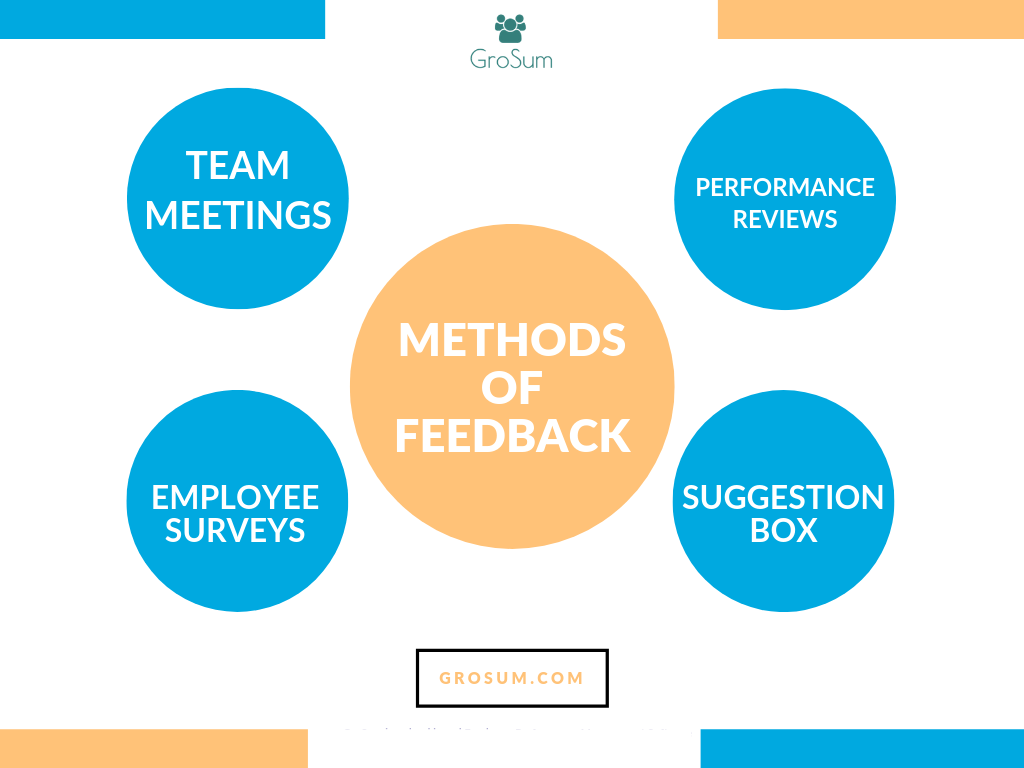
Collecting employee feedback is a good way to get an inside look at how well your business is performing. You can inspire trust and respect in your employees and avoid losing money because of poor administration. Besides, when you gather employee feedback, you display your leadership skills and motivate your workers.
But there are some things that you have to keep in mind when gathering employee feedback. Here are four effective methods to do this and some general recommendations on how to collect employee feedback.

Team Meetings
Team meetings are probably the most widespread way of collecting employee feedback. It is perfect to do these at least once a month, but they can be held as often as once per week or even daily (if you have a smaller team).
Team meetings are great not only for collecting individual employee feedback but also brainstorming ideas on how these aspects can be improved. One head is great, but several are even better.
If you are a fan of such meetings, you can even assign the responsible people at once. Say, you found out that there was a shortage of food in your company’s office. Your employees suggest their ideas on how this can be dealt with. Then you settle down on your chosen solution and assign someone the role of getting things done. This way, you will have issues solved much faster.
On the other hand, such meetings can be harder to host if you are working with freelancers or your employees are in different locations. In this case, you can hold a virtual meeting.
Performance Reviews
While team meetings are a great way to brainstorm, you should not forget about collecting feedback through one-on-one employee performance reviews. These have their own advantages and disadvantages.
For instance, if you speak with your workers individually, they might get nervous and try to find their way out of such a situation by making up things. This is why it is important to have an all-honest atmosphere.
In addition to that, having performance reviews often can take too much time, while having the more rarely and further apart may lead to your employees feeling like their opinion doesn’t matter.
To avoid such things from happening, you can ask your workers to write down their thoughts when on such one-on-one sessions. After that, you can have the content rewritten in a more professional manner by an online service such as Trust My Paper. You can then keep these documents stored and available at any time.
Employee Surveys
As opposed to the nervous feeling your employees might experience during one-on-one sessions, anonymous employee surveys are a great way to encourage your workers to be bolder and more honest with you when providing feedback.
In order to make your survey perfect, try to include questions that are not too broad, because this may result in your workers simply answering in general terms or saying what they think you want to hear. Don’t put words in their mouths either. If you phrase your questions in a way suggestive of a certain answer, you will get that exact reply.
Try to target certain topics by including more detailed and precise questions. If you want opinions on a certain issue, ask about it instead of wondering about.
Lastly, don’t make these surveys too often so that they don’t turn into a chore. Similarly, don’t make them too far apart, because this may lead to them being perceived as something unimportant. Make them an appropriate length instead of only a few questions or a hundred pages long. Find that golden middle.
Suggestion Box
Now, suggestion boxes may seem like an ineffective way of collecting employee feedback, but they can actually be quite helpful if they are set up the right way.
If you already have a physical suggestion box, try to find a place for it where everyone will see it. This will constantly remind your employees to leave their suggestions there. You don’t have to constantly tell them to do it, but if it’s sitting in a good place, it will be used more often than not.
Don’t forget to check the box regularly, and when you receive something, address the issue immediately. Failing to do so will result in your workers deeming the suggestion box ineffective and their opinions worthless.
One of the reasons why suggestion boxes are so good is because of the anonymity that they provide. These are perfect for those of your works who are reluctant to share their thoughts on formal meetings and to your face and would rather do it anonymously.
Alternatively, if you don’t have a physical suggestion box, you can try the virtual option. Virtual suggestion boxes are easier in the sense that you can get notified when someone leaves a message in them and they don’t take any space. You can easily set up a free suggestion box online and tell your workers about it.
Recommendations
In general, employee feedback should be collected with caution. Don’t approach your workers with complaints about their performance. This is not about them right now. You are gathering feedback about your own actions.
Avoid being defensive when they point out some mistakes they noticed. Nobody wants to share their honest opinions when all they get in return are excuses. Own your mistakes and ask what they would propose to make this aspect better.
In order to exclude the possibility of the employee faking their thoughts, try to show your openness to hear what they have to say. Show that you are interested in them and their project and pay attention to their body language to detect any negative thoughts going through their head.
Feedback is about listening. If you don’t listen to your employees, there is no way that the opinions you collected will be effectively analyzed and lessons will be learned from them.
Conclusion
All in all, these are some of the four most effective ways to collect employee feedback. They are proven to bring only real, unbiased opinions from your workers instead of making them opt for faking their thoughts. Follow these tips and you should be able to get all the data you need.
About the author
Diana Nadim is a writer and editor who has a Master degree in Marketing. She combines her passion for writing with her interest in research and creates thought-provoking content in various fields. Diana also runs her own 3to5Marketing blog. What inspires her the most in her writing is traveling and meeting new people. Follow her on Twitter.